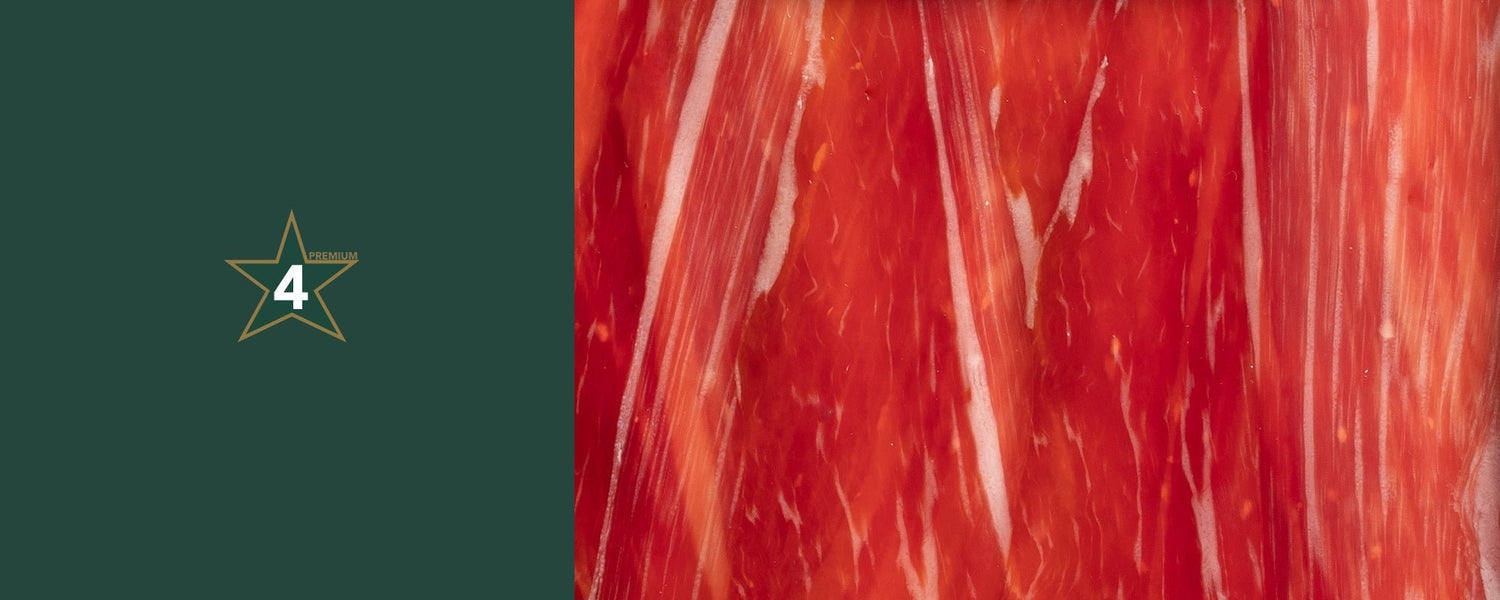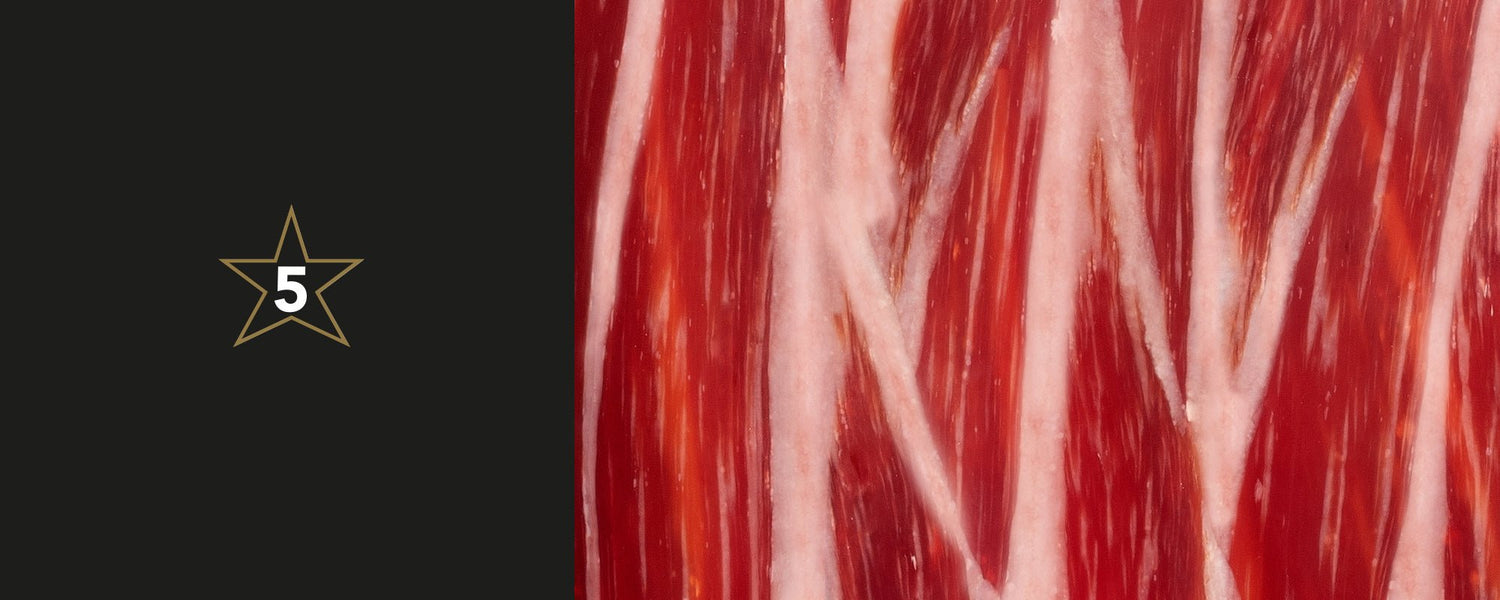ÍNDICE
- Warum gilt der Jamón Ibérico (iberischer Schinken) als der beste?
- Was Sie über Jamón Ibérico wissen müssen
- Die Rasse: das iberische Schwein
- Su alimentación
- La procedencia
- El proceso de curación del jamón ibérico
- Jamón de Bellota 100% Ibérico
- Jamón de Bellota 50% Ibérico
- Jamón de cebo de campo 50% ibérico
- Jamón de cebo 50% ibérico
Why is Jamón Ibérico (Iberian ham) considered the best?
Although it is pretentious to say so, Iberian ham is the jewel in the crown, the most prized range and one of the star products of world gastronomy. This type of ham comes from a unique breed in the world: the Iberian pig. Most of the pigs that belong to this breed live for a long period in a very unique environment: the dehesas (Mediterranean wild pastureland). Here they feed on the famous acorns, which give rise to the name “jamón de bellota ibérico”. Moreover, the curing time of the leg exceeds three years and the treatment it receives during the process is truly exclusive. Iberian ham not only attracts us by the name itself, but -once we taste it- it is its intense and addictive flavour that conquers.
What you need to know about Jamón Ibérico
Did you know that Jamón ibérico corresponds to the hind leg of the authentic Iberian Peninsula pig? Let's start at the beginning, investigating a little more about this Jamón based on three variables that allow us to differentiate it perfectly: the breed, the diet and the origin.
The breed: the Iberian pig
The Iberian pig is a unique species with characteristics that differentiate it from other animals of the same species, such as, for example, the ability to infiltrate fat into the muscle. Physically speaking, these animals have a well-proportioned head and a pointed snout, unlike other types of pigs, the Iberian pig has a powerful neck, a drooping dewlap, medium-sized ears in the shape of a visor and a large belly. Its limbs, the ones we are most interested in when talking about ham, are slender.
According to the legislation that regulates the production of Jamón Ibérico, the denomination "Iberian pig" includes all those pigs whose mother is 100% Iberian and is registered in the herd book of the Iberian Pig Breed. The offspring of this pig, and therefore the products produced from them, can have different percentages of breed purity: 50%, 75% or 100%.
Their diet
In addition to the breed, in order to differentiate the Iberian pigs from the rest and give them a category among them, it is necessary to take into account the diet. Iberian ham can be of two types: de campo ibérico or de bellota ibérico. And here we ask the question: what is the main difference between them? Their diet.
On the one hand, the de cebo iberico pigs, which live on farms, are fed on feed and cereals. On the other hand, the de cebo de campo iberico pigs combine farm life with grazing in the fields in freedom, so they are fed a combination of fodder and wild fruits that they gather from the fields.
On the other hand, the Iberian pigs that produce de bellota iberico ham are those that make the "montanera" and live freely in the pastures during the autumn and winter, feeding on acorns and other grasses and fruits from the wild. The acorns have an exquisite oil that the pig infiltrates into its muscle, turning it into very precious fat, which is what makes it melt in your mouth when you taste it.
Origin
In the world of Jamón, its origin has always been taken into account, and even more so when it comes to Jamón ibérico / Iberian ham. We are talking about the famous denomination of origin (D.O.). Iberian pigs are native to the Iberian Peninsula: shared between Spain and Portugal. There are different breeding areas in the Peninsula (Salamanca, Extremadura, Andalusia...). These areas are the ones that define their origin and although they all share a very favourable Mediterranean climate, the final result after the end of each Montanera can vary from one production batch to another. Of course, the way and the tradition of the master ham makers in the production process will be decisive in the final result of the product, both in its flavour and in the range of aromas. This is why no two hams are the same, even if they are made by the same hands and come from the same batch.
That is why at Enrique Tomás we classify our Jamón in the most natural way for our customers: according to flavour. Thus, you will find a ham that is mild, aromatic, tasty or intense. They will have other adjectives but they will stand out in one of them. We try to tell our customers what they are looking for in the best possible way.
The areas where the Iberian pigs live in freedom are called 'dehesas' and correspond to a few hectares of land where the conditions are favourable for the pigs to graze and live during the autumn and winter, feeding on acorns.
The curing process of Jamón Ibérico
Another of the most important variables to take into account in order to differentiate the Iberian ham, and above all the 100% Iberian ham from the rest, is, as we say in Enrique Tomas: "the cooking". This cooking is nothing more and nothing less than the conditions in which the leg is preserved, in the amount of salt, the storage temperature and the curing time. In short, a Jamón is cured with time, wisdom, care and salt.
In the case of Jamón ibérico, it can take five years from the time the animal is born, when the whole process is finished and we buy it. For curing, the ham has to be salted and left to cure at an exact temperature. This curing process lasts between thirty-six and forty-eight months, depending on the weight of each piece.
Jamón de Bellota 100% Ibérico
The most prized of all is the Jamón bellota 100% iberico, popularly known as pata negra. Of 100% Iberian breed, these pigs are free-range pigs that, during the montanera, have been fed with acorns, wild plants and herbs, the final product of this animal could not be other than a meat with an exceptional flavour thanks to the infiltration of fat in the muscle, as well as to the feeding and care to which it has been subjected. Eating this Jamón is a pleasure. As we say at Enrique Tomás: "Nobody eats ham for hunger relief”, we eat it to enjoy it.
Jamón de Bellota 50% Ibérico
The only difference with the previous one is its breed. The Jamón de Bellota 50% Ibérico lives in the same conditions as the 100% Iberian ham, it is fed on acorns, even though it is not 100% Iberian because of its breed. It comes from a 100% Iberian mother that has been crossed with a pig of another species such as the Duroc or the common white pig.
Jamón de cebo de campo 50% ibérico
This is an Iberian ham from an Iberian pig reared on a farm but which has been fed twice: once on the farm with feed and once free range in the countryside with wild herbs and plants. A delicious ham.
Jamón de cebo 50% ibérico
A ham from an Iberian pig reared and fed entirely on the farm and on feed.
FAQs
CAN JAMÓN IBÉRICO BE MADE IN OTHER PARTS OF THE WORLD?
No, Iberian ham can only be made on the Iberian Peninsula, its place of birth and origin.
HOW IS THE JAMÓN BELLOTA 100% IBÉRICO DIFFERENT FROM THE REST?
It comes from a 100% Iberian mother and father and has been reared in the wild in the pasture feeding on acorns. In addition, it has a magnificent intense and delicious flavour, difficult to find in other hams on the market.
WHY DOES THE CURING TIME VARY SO MUCH?
It depends a lot on the weight of each piece, i.e., in 24 months we could make a seven-kilo Iberian ham, but we will need 48 months to achieve the same curing point of a ten-kilo ham.
IS THE FAT IN A JAMÓN IBÉRICO GOOD?
The fat infiltrated in the middle of the ham is recommended and very good, but the fat around the edges, although very tasty, is not recommended. The yellow fat that surrounds the ham should be removed because it only serves to protect but is not recommended for consumption.
WHY BUY JAMÓN ENRIQUE TOMÁS BELLOTA 100% IBÉRICO?
It is a selected ham, 100% made in Spain. The ham experts at Enrique Tomás go all over the country to select the best 100% Iberian hams and that is why we call them "premium". In addition, we follow a very exhaustive quality control during the whole process. From the drying room we send it directly to your home, so that you can enjoy its great flavour in the most authentic way.
HOW DO I DISTINGUISH THE TYPE OF JAMÓN IBÉRICO I BUY?
At Enrique Tomás, following the legislation, we identify the Jamón Ibérico with the label and the flange. The 5 star Premium is for the 100% Iberian ham with the label and the black flange. The 5 stars label and the red flange is for the 50% Iberian ham. The 4 stars Premium is the one used to identify the Iberian cebo campo with the green label and the green flange and the 4 stars Iberian cebo with the white label and flange.















